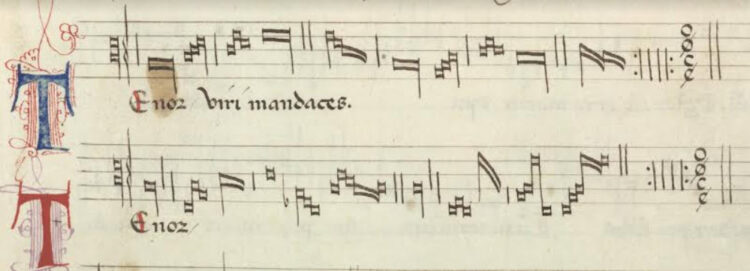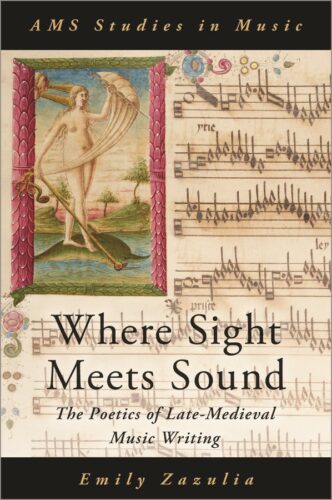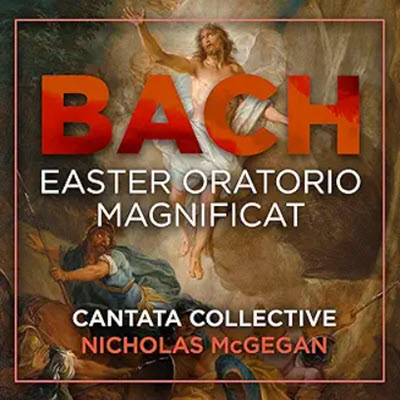by William Watson
Published November 26, 2023
Where Sight Meets Sound: The Poetics of Late-Medieval Music Writing by Emily Zazulia. Oxford University Press.

It can be daunting to write about notation, such a well-trod topic in musicology. But Emily Zazulia, in Where Sight Meets Sound, a study of music writing in late-Medieval Europe, has not merely risen to this challenge but has handily exceeded it. Her book, which focuses on the 15th century while covering material from the late 13th through the early 16th centuries, is that rare contribution that not only enriches our understanding of the period and repertoire it scrutinizes, but also shows how early music still has valuable insights to offer the broader world of music studies. This book is a must-read for early-music specialists and a worthwhile investment for any student of music history.
Zazulia’s introduction lays out a theoretical armature for her project, in which three “metaphors for music writing” — technology, language, discourse — allow her to deftly disentangle some of the terminological confusion that often bedevils the study of pre-modern music notation.

The first three of seven chapters subtly subvert a reader’s expectations by avoiding the obvious strategy of sequentially exploring each metaphor, and instead show how this constellation of metaphors can yield insights at different levels of historical details. The first chapter surveys the ways in which durational transformations were indicated from the 13th through the 15th centuries. Zazulia gradually zooms in through the second chapter’s exploration of a handful of pieces from the late 14th and early 15th centuries that collectively confound simple understandings of “rhythm.” She then arrives at the third chapter’s focused critique of the interpretive discourse that has built up around Guillaume Du Fay’s 1436 ceremonial motet Nuper rosarum flores.
The final four chapters deploy analyses at several levels of detail in pursuit of more abstract topics. The fourth chapter examines a distinction between what Zazulia calls musical “signs” and “metasigns,” while showing how the possibility of such a distinction was itself a consequence of changing notational practices in the decades after 1400. The fifth and sixth chapters explore two ways in which this theoretical distinction manifested aesthetically and compositionally, first in the pairing of a desire to maintain the appearance of pre-existing notation (whether chant or secular song) with an interest in transforming the musical sounds indicated by that notation, and then in the bewildering number of ways in which composers indicated rhythmic augmentation in the later 15th century. The seventh chapter explores extreme examples of notational practice that, by pushing against the outer limits of what is possible, give unique insights into their aesthetic contexts. Finally, a conclusion summarizes the book’s broader implications.
Zazulia, on the UC-Berkeley faculty, has a rare command of the nuances of Medieval notation. This deep familiarity with the source material undergirds many of the book’s most compelling moments. The third chapter’s careful argument against any special, analogically meaningful connection between the mensural scheme of Nuper rosarum flores and its ceremonial context is an obvious standout in this regard, but it is far from alone. The sixth chapter’s discussion of the Missa Gross senen is similarly incisive, and the second chapter’s analyses of how different terminological systems reveal and obscure distinct aspects of 14th-century motet tenors are remarkably lucid for their subtlety. Zazulia also has a gift for translating her arguments into visual formats, and the many annotated examples, tables, and figures that appear throughout the book are of great help in making a difficult subject more accessible.
And yet, the book’s greatest coup is arguably the sensitive theoretical and methodological discussions that both permeate and encapsulate it. Not only do the three metaphors of music writing that Zazulia introduces at the book’s opening deeply inform and strengthen the arguments made in each chapter, but the author also shows how the notational practices she discusses stand to enrich our understanding of them.

Indeed, her conclusion goes well beyond a reevaluation of received narratives about the complexity of late-Medieval notation (though that is certainly there, crystallized in her useful three-category scheme). It additionally suggests how these analyses of abstruse Medieval notation might inform broader debates currently taking place at the intersections of music, aesthetics, technology, and language — debates that often exhibit historical blind spots about music outside of the “common practice.” (Zazulia’s meditation on the implications of her research for disputations about the nature of musical “works” merits special attention in this regard.)
If Zazulia’s book has a weakness, it’s that a longstanding hesitancy within 15th-century music studies to engage deeply and explicitly with debates of this kind occasionally requires her to adopt a mildly defensive rhetorical stance that might not be necessary in other musicological subfields. But rather than linger over the shadow cast by the discipline’s past, let us instead look to a future made brighter and more intellectually capacious by a book of this ambition and quality.
William Watson earned a Ph.D. in historical musicology from Yale University in 2020, where his research focused on late-Medieval European song repertoires. He currently works as a data scientist in Washington, DC.




